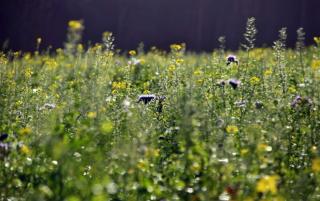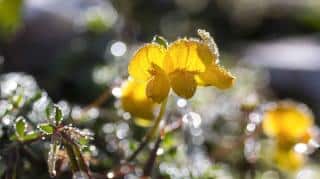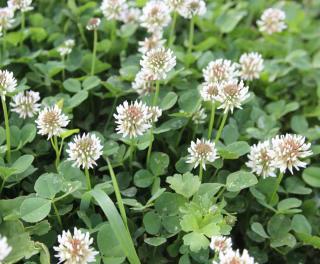

It protects the ground from weeds and enriches the soil with nitrogen and humus: green manure scores perfect on all counts!
Sow it in the vegetable patch as soon as a plot is free.
Green manure is what fast-growing plants used to cover the ground are called after a plot has been harvested. Medick, clover, mustard, phacelia, white lupine, rape… these are all useful plants.
If sown in the vegetable patch as soon as the ground is bare, they keep weeds from settling in, avoid erosion due to rain, and for places with high slopes, they guard against landslides. Their roots hold the soil together and thread through the ground, making it lighter. Once they’re buried, they break down and provide nutrients that make it richer.
Green manure is sown just like a lawn, simply broadcast on soil that has simply been run over with a rake. You can sow at the beginning of spring, the end of summer or in fall, before it freezes. A good practice is to sow just after you’ve harvested.
 Cover with a thin layer of soil, press down, and water.
Cover with a thin layer of soil, press down, and water.After that, before the plants bolt or go to seed, mow the green manure on the patch or cut it with a scythe, dry it for a few days and turn the soil over to bury it with a spade. Four to eight weeks later, depending on the plant, you can start your seedlings and regular crops.
 Depending on your soil type, some plants will do a better job than others. Medick and mustard are great green manure for clay soil, while phacelia will grow on any type of soil. Whatever you plan to grow later on the plot can influence the decision, too.
Depending on your soil type, some plants will do a better job than others. Medick and mustard are great green manure for clay soil, while phacelia will grow on any type of soil. Whatever you plan to grow later on the plot can influence the decision, too.
 Best avoid growing Brassicacaea or cruciferae (radish, cabbage, watercress, turnip…) after mustard, rape or turnip rape, because the same diseases can transfer to all of these species.
Best avoid growing Brassicacaea or cruciferae (radish, cabbage, watercress, turnip…) after mustard, rape or turnip rape, because the same diseases can transfer to all of these species.Laure Hamann